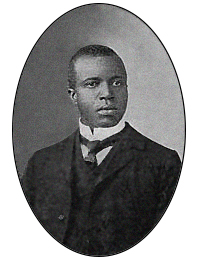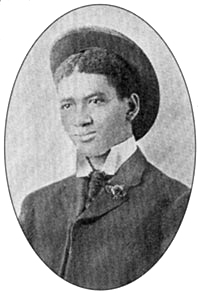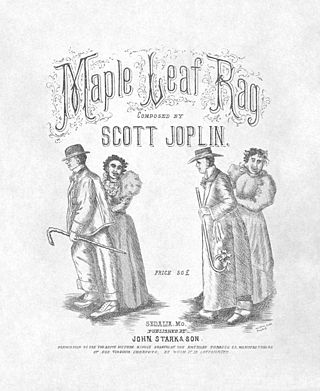Ragtime, also spelled rag-time or rag time, is a musical style that had its peak from the 1890s to 1910s. Its cardinal trait is its syncopated, or "ragged" rhythm. Ragtime was popularized during the early 20th century by composers such as Scott Joplin, James Scott and Joseph Lamb. Ragtime pieces are typically composed for and performed on piano, though the genre has been adapted for a variety of instruments and styles.

Scott Joplin was an American composer and pianist. Dubbed the "King of Ragtime", he composed more than 40 ragtime pieces, one ragtime ballet, and two operas. One of his first and most popular pieces, the "Maple Leaf Rag", became the genre's first and most influential hit, later being recognized as the quintessential rag. Joplin considered ragtime to be a form of classical music meant to be played in concert halls and largely disdained the performance of ragtime as honky tonk music most common in saloons.

Joseph Francis Lamb was an American composer of ragtime music. Lamb, of Irish descent, was the only non-African American of the "Big Three" composers of classical ragtime, the other two being Scott Joplin and James Scott. The ragtime of Joseph Lamb ranges from standard popular fare to complex and highly engaging. His use of long phrases was influenced by classical works he had learned from his sister and others while growing up, but his sense of structure was potentially derived from his study of Joplin's piano rags. By the time he added some polish to his later works in the 1950s, Lamb had mastered the classic rag genre in a way that almost no other composer was able to approach at that time, and continued to play it passably as well, as evidenced by at least two separate recordings done in his home, as well as a few recorded interviews.

James Sylvester Scott was an American ragtime composer and pianist. He is regarded as one of the "Big Three" composers of classical ragtime along with Scott Joplin and Joseph Lamb.

The cakewalk was a dance developed from the "prize walks" held in the mid-19th century, generally at get-togethers on Black slave plantations before and after emancipation in the Southern United States. Alternative names for the original form of the dance were "chalkline-walk", and the "walk-around". It was originally a processional partner dance performed with comical formality, and may have developed as a subtle mockery of the mannered dances of white slaveholders.

The "Maple Leaf Rag" is an early ragtime musical composition for piano composed by Scott Joplin. It was one of Joplin's early works, becoming the model for ragtime compositions by subsequent composers. It is one of the most famous of all ragtime pieces. Its success led to Joplin being dubbed the "King of Ragtime" by his contemporaries. The piece gave Joplin a steady if unspectacular income for the rest of his life.

Percy Wenrich was an American composer of ragtime and popular music. He is best known for writing the songs "Put on Your Old Grey Bonnet" and "When You Wore a Tulip and I Wore a Big Red Rose", along with the rag "The Smiler". For more than 15 years, Wenrich toured with his wife, vaudeville performer, Dolly Connolly; for whom he wrote several hit songs, including "Red Rose Rag", "Alamo Rag" and "Moonlight Bay". He was known throughout his lifetime as "The Joplin Kid".

"The Entertainer" is a 1902 classic piano rag written by Scott Joplin.

The "Swipesy Cakewalk" is a ragtime composition written in 1900 by a musical duo consisting of Scott Joplin, who composed the trio, and the young composer Arthur Marshall, who composed the rest of the piece. "Swipesy" uses the simple syncopations of a cakewalk - the first beat being a sixteenth, eighth, sixteenth note division, and the second beat an even eighth note division. The style follows the AA BB A CC DD musical form common for both cakewalks and rags, particularly after the earlier publication of Joplin's hit "Maple Leaf Rag". Only the C section, composed by Joplin, departs from the cakewalk rhythm and is more pure ragtime. The composition was written in the late 1890s when Joplin was living with the Marshall family, and was teaching Arthur composition.
short description=early American ragtime composer

"Magnetic Rag" is a 1914 ragtime piano composition by American composer Scott Joplin. It is significant for being the last rag which Joplin published in his lifetime, three years before his death in 1917. It is also unique in form and in some of the musical techniques employed in the composition.

"Original Rags" was an early ragtime medley for piano. It was the first of Scott Joplin's rags to appear in print, in early 1899, preceding his "Maple Leaf Rag" by half a year.

"Bethena, A Concert Waltz" is a composition by Scott Joplin. It was the first Joplin work since his wife Freddie's death on September 10, 1904, of pneumonia, ten weeks after their wedding. At the time the composer had significant financial problems; the work did not sell successfully at the time of publication and was soon neglected and forgotten. It was rediscovered as a result of the Joplin revival in the 1970s and has received acclaim from Joplin's biographers and other critics. The piece combines two different styles of music, the classical waltz and the rag, and has been seen as demonstrating Joplin's excellence as a classical composer. The work has been described as "an enchantingly beautiful piece that is among the greatest of Ragtime Waltzes", a "masterpiece", and "Joplin's finest waltz".
Knocky Parker, born John William Parker, II, was an American jazz pianist. He played primarily ragtime and Dixieland jazz.
Brun Campbell was an American composer and pianist.

The "Searchlight Rag" is a ragtime composition by Scott Joplin, first published in 1907. It was named after the town of Searchlight, Nevada, where his friends had gone prospecting, inspiring the title.
Adaline Shepherd was an American composer of piano pieces. Though she did not compose many pieces, the pieces she composed were popular. In her twenties, she composed three ragtime pieces: "Pickles and Peppers" (1906), "Wireless Rag" (1909), and "Live Wires Rag" (1910). Commemorating World War I, she also published "Victory" (1918). She married Frederick Sherman Olson in 1910, and thereafter used his last name as her own.

Irene Cozad, later known as Irene Cozad-Sherer, was an American pianist, piano teacher, and composer of ragtime music.















